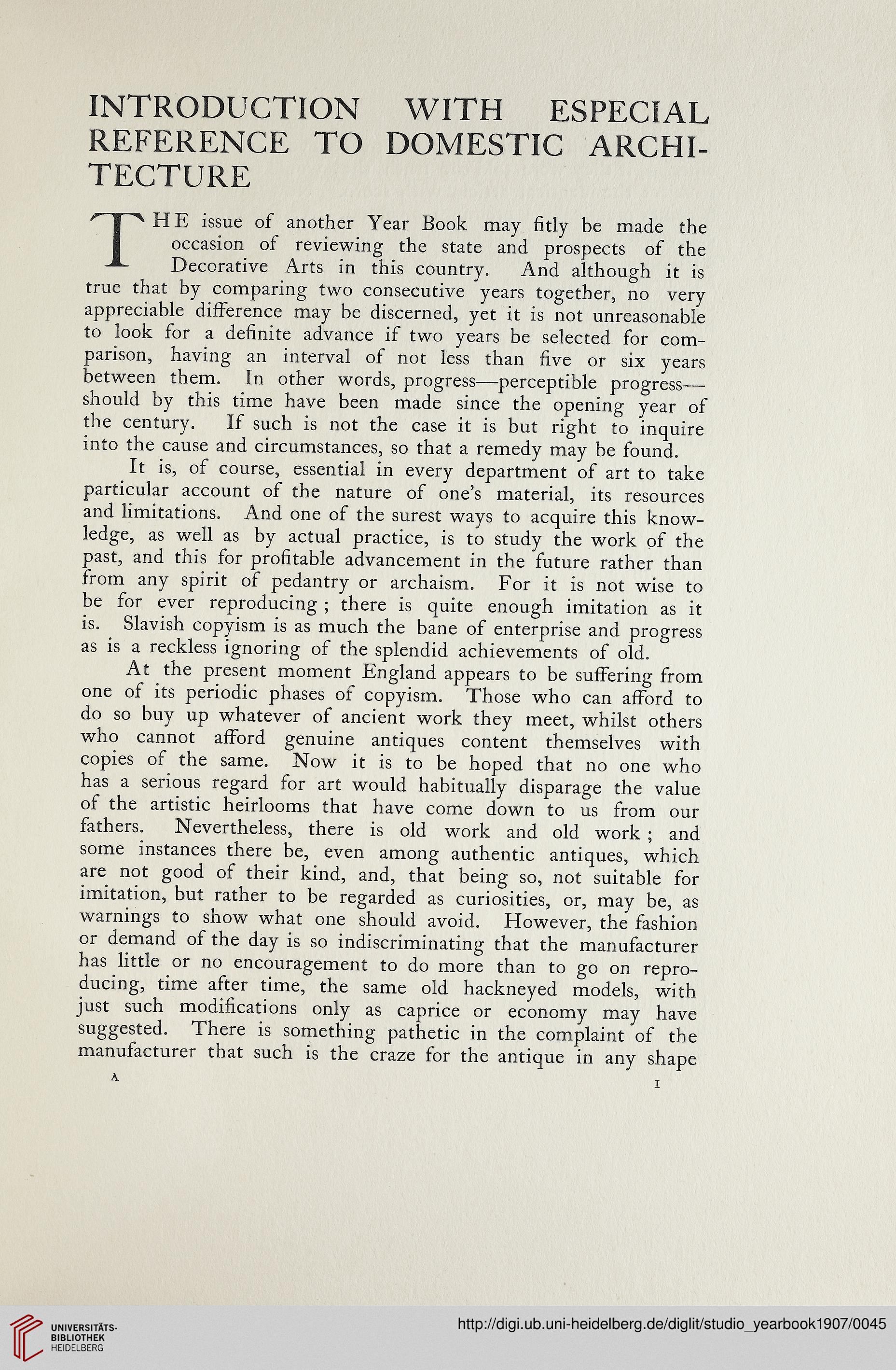INTRODUCTION WITH ESPECIAL
REFERENCE TO DOMESTIC ARCHI-
TECTURE
THE issue of another Year Book may fitly be made the
occasion of reviewing the state and prospects of the
Decorative Arts in this country. And although it is
true that by comparing two consecutive years together, no very
appreciable difference may be discerned, yet it is not unreasonable
to look for a definite advance if two years be selected for com-
parison, having an interval of not less than five or six years
between them. In other words, progress—perceptible progress—
should by this time have been made since the opening year of
the century. If such is not the case it is but right to inquire
into the cause and circumstances, so that a remedy may be found.
It is, of course, essential in every department of art to take
particular account of the nature of one’s material, its resources
and limitations. And one of the surest ways to acquire this know-
ledge, as well as by actual practice, is to study the work of the
past, and this for profitable advancement in the future rather than
from any spirit of pedantry or archaism. For it is not wise to
be for ever reproducing ; there is quite enough imitation as it
is. Slavish copyism is as much the bane of enterprise and progress
as is a reckless ignoring of the splendid achievements of old.
At the present moment England appears to be suffering from
one of its periodic phases of copyism. Those who can afford to
do so buy up whatever of ancient work they meet, whilst others
who cannot afford genuine antiques content themselves with
copies of the same. Now it is to be hoped that no one who
has a serious regard for art would habitually disparage the value
of the artistic heirlooms that have come down to us from our
fathers. Nevertheless, there is old work and old work ; and
some instances there be, even among authentic antiques, which
are not good of their kind, and, that being so, not suitable for
imitation, but rather to be regarded as curiosities, or, may be, as
warnings to show what one should avoid. However, the fashion
or demand of the day is so indiscriminating that the manufacturer
has little or no encouragement to do more than to go on repro-
ducing, time after time, the same old hackneyed models, with
just such modifications only as caprice or economy may have
suggested. There is something pathetic in the complaint of the
manufacturer that such is the craze for the antique in any shape
REFERENCE TO DOMESTIC ARCHI-
TECTURE
THE issue of another Year Book may fitly be made the
occasion of reviewing the state and prospects of the
Decorative Arts in this country. And although it is
true that by comparing two consecutive years together, no very
appreciable difference may be discerned, yet it is not unreasonable
to look for a definite advance if two years be selected for com-
parison, having an interval of not less than five or six years
between them. In other words, progress—perceptible progress—
should by this time have been made since the opening year of
the century. If such is not the case it is but right to inquire
into the cause and circumstances, so that a remedy may be found.
It is, of course, essential in every department of art to take
particular account of the nature of one’s material, its resources
and limitations. And one of the surest ways to acquire this know-
ledge, as well as by actual practice, is to study the work of the
past, and this for profitable advancement in the future rather than
from any spirit of pedantry or archaism. For it is not wise to
be for ever reproducing ; there is quite enough imitation as it
is. Slavish copyism is as much the bane of enterprise and progress
as is a reckless ignoring of the splendid achievements of old.
At the present moment England appears to be suffering from
one of its periodic phases of copyism. Those who can afford to
do so buy up whatever of ancient work they meet, whilst others
who cannot afford genuine antiques content themselves with
copies of the same. Now it is to be hoped that no one who
has a serious regard for art would habitually disparage the value
of the artistic heirlooms that have come down to us from our
fathers. Nevertheless, there is old work and old work ; and
some instances there be, even among authentic antiques, which
are not good of their kind, and, that being so, not suitable for
imitation, but rather to be regarded as curiosities, or, may be, as
warnings to show what one should avoid. However, the fashion
or demand of the day is so indiscriminating that the manufacturer
has little or no encouragement to do more than to go on repro-
ducing, time after time, the same old hackneyed models, with
just such modifications only as caprice or economy may have
suggested. There is something pathetic in the complaint of the
manufacturer that such is the craze for the antique in any shape





